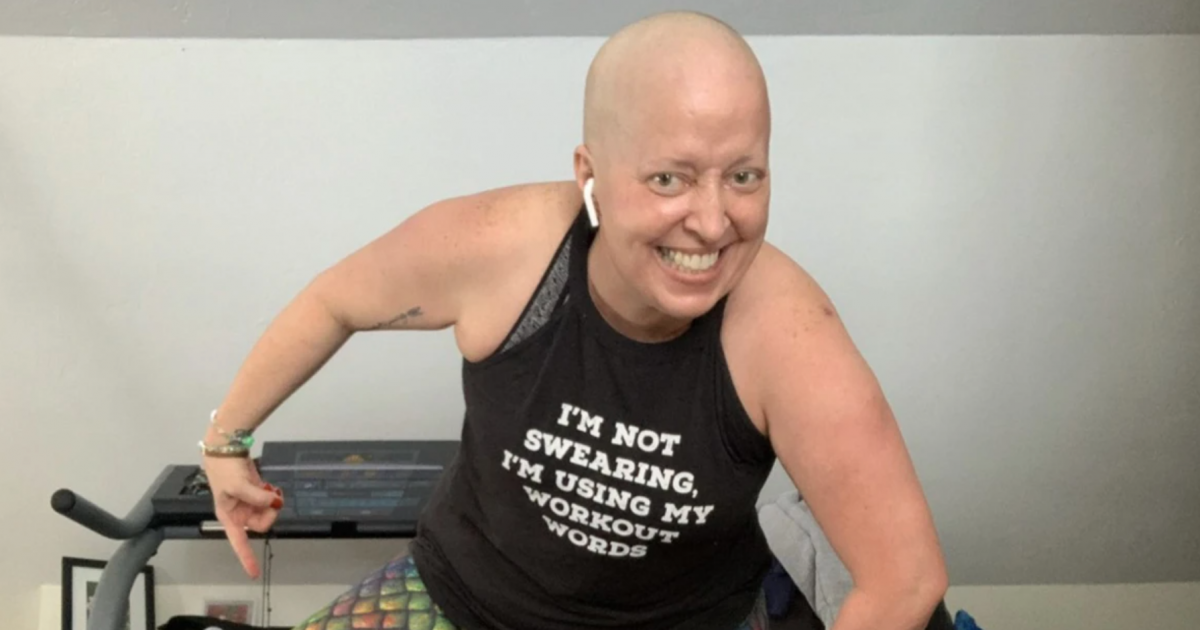She Won't Back Down ... and Neither Should You
- Elementary school teacher Heidi Richard, 47, suffered from strange symptoms for an entire year and knew deep down something was wrong, despite doctors dismissing her condition as anxiety; It was stage 4 lymphoma.
- The avid runner, who is thankfully now in remission and about to run her first Boston Marathon, chronicles her journey to urge others to always fight for a proper diagnosis.
- Although non-Hodgkin lymphoma is difficult to diagnosis, flu-like symptoms, back pain, and night sweats are among the top common symptoms of the disease.
The typically healthy runner, who is now getting ready to run the Boston Marathon, started experiencing “severe stomach pains at night, vomiting and night sweats,” in the spring of 2019.
Read MoreThe bottom line, however, is that many people know their bodies. And she just knew something was off. It’s important to always follow your intuition when it comes to your health. It can be common to be labeled “paranoid” even, but it’s better to be safe than sorry and continue investigating until you get to the bottom of your symptoms, especially when they get more and more extreme.
“I kept having severe stomach pains and vomiting,” Heidi wrote. “I lost 30 pounds unintentionally and had gotten pretty thin. I was trying to eat, but I was just unable to I was just getting so sick.”
Related: Doctors Ignore Mom Who Says Her ‘Womanly Instincts’ Sensed Breast CancerTrust Your Gut
She was put on anxiety medication and antacid. Then, she was having stomach issues day and night. Her back hurt. She was more tired than usual while training for the Providence Marathon. Then her neck began to swell.
Again, doctors put her off, and said it must be a pulled muscle and gave her a muscle relaxer. Thankfully, she insisted on an imaging test. Sure enough, it came back showing “something suspicious.”
‘Be Pushy, Be Your Own Advocate, Don’t Settle,’ Leading Expert Says
Heidi’s Diagnosis
In April 2020, Heidi was finally diagnosed with stage 4 diffuse large B-cell lymphoma, which is a type of non-Hodgkin lymphoma.
“It was everywhere: my abdomen, spleen, bone marrow, sternum, lungs, groin and neck,” she shared of her devastating news. “A mass in my abdomen was pushing my intestines to the sidethat's why I was having those stomach pains.”
Heidi immediately underwent chemotherapy for several months. In January 2021, she had an autologous stem cell transplant, which, according to the National Cancer Institute, “replaces a patient's stem cells that were destroyed by treatment with radiation or high doses of chemotherapy.” She currently receives immunotherapy, and goes for an infusion ever few weeks.
Heidi couldn’t help but question whether her gender played a role in her continuous dismissal of symptoms by doctors. Regardless, she “fought” back, and urges others to do the same.
“Know what your baseline is and when something is wrong, don't be afraid to ask for a second opinion or ask for that test,” Heidi says. “Don't be afraid of sounding like a hypochondriacthat's what I was afraid of and luckily I spoke up when I did, because finally I had enough.”
Luckily, the brave mom is now in remission, and this Boston Marathon is her first.

“I'm not as fast a runner as I used to be,” Heidi admits, “I get tired more easily, so I have to take walking breaks. But no matter what happens, I know I'm going to finish. I'm lucky enough to be healthy enough to be out there for the Boston Marathon and doing what I love to do.”
Symptoms of Non-Hodgkin Lymphoma
As mentioned, lymphoma is a cancer that often creeps in silently, without symptoms. Even when people do have signs, they don't necessarily point directly to cancer. For example, swollen glands are indeed much more likely to be from an upper respiratory infection than lymphoma.
The sneaky nature of symptoms, coupled with a lack of screening for the disease, leads many people to be diagnosed at an advanced stage, like Heidi. By that point, the cancer may have already spread throughout their body. Yet even at a late stage, the outlook isn't as dire as many people might assume.
Although non-Hodgkin lymphoma is difficult to diagnosis, flu-like symptoms, back pain, and night sweats are among the top common symptoms of the disease, which also include:
- Fever
- Swollen lymph nodes in the neck, armpits, or groin or
- Chest pain
- Abdominal pain
- Coughing
- Trouble breathing
- Constant fatigue
- Night sweats
- Sudden and unexplained weight loss
Individuals who suddenly experience any of these symptoms should consider scheduling an appointment with a doctor, and as Heidi suggests, don’t put up with being put off.
The Stages of Lymphoma
Staging is a process your doctor uses to find out whether your non-Hodgkin lymphoma has spread, and where it is in your body. The results of your exams, blood tests, imaging tests such as PET and CT scans, and biopsy go into determining your stage.
Yet staging non-Hodgkin lymphoma isn't as straightforward a process as staging solid tumors such as breast or lung cancer. That's because lymphocytes, the cells that turn into cancer in non-Hodgkin lymphoma, travel throughout the body.
Related: All about Biopsies for Non-Hodgkin Lymphoma
"While [staging is] important, it doesn't necessarily have the same level of importance as certain solid tumors, because of the propensity of lymphocytes to circulate," Dr. Lawrence Piro, medical oncologist with The Angeles Clinic & Research Institute in Los Angeles, explains to SurvivorNet.
And although people are often diagnosed with lymphoma at a late stage, "The stages are often equally treatable," he adds.
The Stages of Non-Hodgkin Lymphoma How Your Stage Affects Your Outlook
Non-Hodgkin lymphoma has four stages:
- Stage I means the cancer is only in one area of lymph nodes.
- Stage II is when the cancer is in two or more groups of lymph nodes, but the nodes are on the same side (either above or below) the diaphragm the thin layer of muscle that separates the chest from the abdomen.
- Stage III is when the cancer is in lymph nodes both above and below the diaphragm, or is only in lymph nodes above the diaphragm, but also in the spleen.
- Stage IV tends to be more widespread disease, where the cancer has spread to at least one organ outside of the lymph system, such as the lung, liver, or bone marrow.
Learn more about SurvivorNet's rigorous medical review process.

